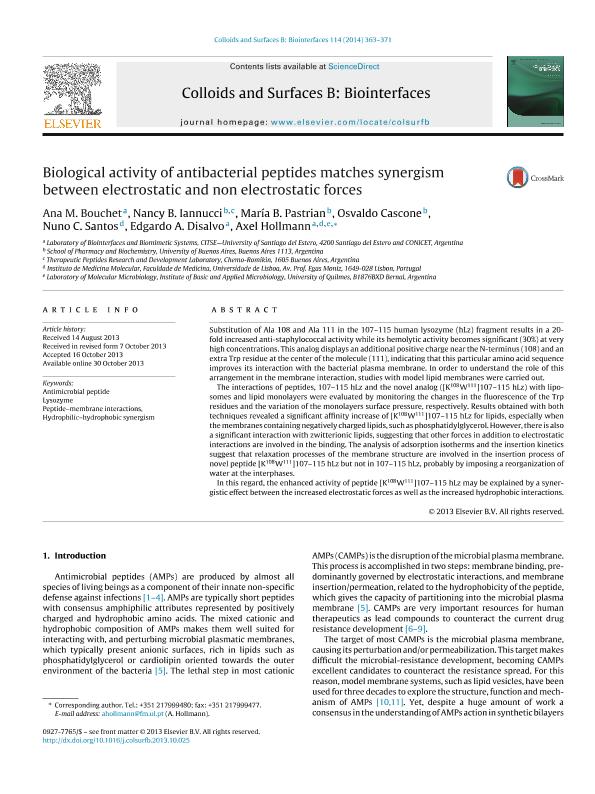Artículo
Biological activity of antibacterial peptides matches synergism between electrostatic and non electrostatic forces
Bouchet, Ana María ; Iannucci, Nancy Beatriz
; Iannucci, Nancy Beatriz ; Pastrian, María Belén
; Pastrian, María Belén ; Cascone, Osvaldo
; Cascone, Osvaldo ; Santos, Nuno C.; Disalvo, Edgardo Anibal
; Santos, Nuno C.; Disalvo, Edgardo Anibal ; Hollmann, Axel
; Hollmann, Axel
 ; Iannucci, Nancy Beatriz
; Iannucci, Nancy Beatriz ; Pastrian, María Belén
; Pastrian, María Belén ; Cascone, Osvaldo
; Cascone, Osvaldo ; Santos, Nuno C.; Disalvo, Edgardo Anibal
; Santos, Nuno C.; Disalvo, Edgardo Anibal ; Hollmann, Axel
; Hollmann, Axel
Fecha de publicación:
07/2014
Editorial:
Elsevier Science
Revista:
Colloids and Surfaces B: Biointerfaces
ISSN:
0927-7765
Idioma:
Inglés
Tipo de recurso:
Artículo publicado
Clasificación temática:
Resumen
Substitution of Ala 108 and Ala 111 in the 107–115 human lysozyme (hLz) fragment results in a 20- fold increased anti-staphylococcal activity while its hemolytic activity becomes significant (30%) at very high concentrations. This analog displays an additional positive charge near the N-terminus (108) and an extra Trp residue at the center of the molecule (111), indicating that this particular amino acid sequence improves its interaction with the bacterial plasma membrane. In order to understand the role of this arrangement in the membrane interaction, studies with model lipid membranes were carried out. The interactions of peptides, 107–115 hLz and the novel analog ([K108W111]107–115 hLz) with liposomes and lipid monolayers were evaluated by monitoring the changes in the fluorescence of the Trp residues and the variation of the monolayers surface pressure, respectively. Results obtained with both techniques revealed a significant affinity increase of [K108W111]107–115 hLz for lipids, especially when the membranes containing negatively charged lipids, such as phosphatidylglycerol. However,there is also a significant interaction with zwitterionic lipids, suggesting that other forces in addition to electrostatic interactions are involved in the binding. The analysis of adsorption isotherms and the insertion kinetics suggest that relaxation processes of the membrane structure are involved in the insertion process of novel peptide [K108W111]107–115 hLz but not in 107–115 hLz, probably by imposing a reorganization of water at the interphases. In this regard, the enhanced activity of peptide [K108W111]107–115 hLz may be explained by a synergistic effect between the increased electrostatic forces as well as the increased hydrophobic interactions.
Archivos asociados
Licencia
Identificadores
Colecciones
Articulos(NANOBIOTEC)
Articulos de INSTITUTO DE NANOBIOTECNOLOGIA
Articulos de INSTITUTO DE NANOBIOTECNOLOGIA
Articulos(SEDE CENTRAL)
Articulos de SEDE CENTRAL
Articulos de SEDE CENTRAL
Citación
Bouchet, Ana María; Iannucci, Nancy Beatriz; Pastrian, María Belén; Cascone, Osvaldo; Santos, Nuno C.; et al.; Biological activity of antibacterial peptides matches synergism between electrostatic and non electrostatic forces; Elsevier Science; Colloids and Surfaces B: Biointerfaces; 114; 7-2014; 363-371
Compartir
Altmétricas



